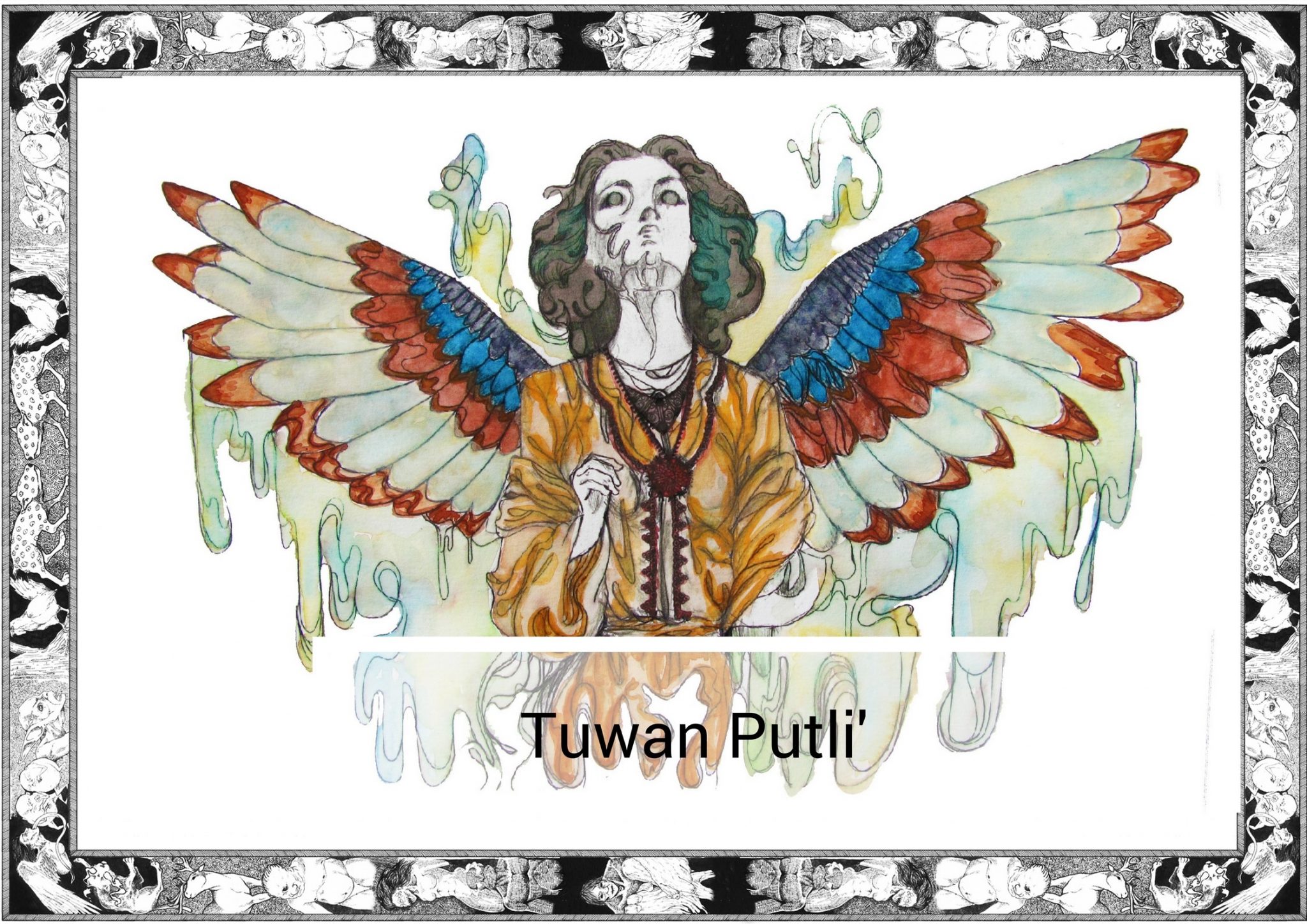
*Note this story is in Cebuano
“Mama, suginli pa ra gud ko og istorya. Dili man gud ko katulog.”
“Sige ba, tara sa imung higdaanan, ‘nak.
Akoa na ba kang naingnan sa istorya sa mga anghel ni Sitti Maryam?”
“Wala pa, mama.”
“Sige, paminawʼg tarong.
Niadtong nag-inusara si Sitti Maryam sa kamingawan arun buhion ang pinakamaayong propeta nga si Nabiʼ Isa, wala siya gipasagdan sa Ginoo. Nagpadala ang Ginoo og 77 ka mga babayeng anghel arun bantayan ang bata, ug ang ilang lider kay si Tuwan Putliʼ. Gwapa siya nga anghel ug naay lapad nga mga pako. Siya ra pud ang natahasang makipag-istorya kay Sitti Maryam sa mga dapat nilang himuon.
Iyang giingan ang 70 ka mga anghel nga puwede na muhawa sa ikapito kaadlaw human maanak si Nabiʼ Isa, ug ang laing 6 ka mga anghel ang magpabilin hantod sa ika-44 kaadlaw bago sila mubalik sa langit. Maayo ug buotan kaayo si Tuwan Putliʼ ug permi niyang ginasiguro nga dili maunsa ang bata.
Sa kamingawan sa isla, kauban si Sitti Maryam ug ang mga anghel, nakulbaan sila ug nangalisang sa mga nagkalain-laing ihalas nga hayop sa mga kakahuyan ug kabatoan. Wala mahadlok ang mga anghel ug ilang giprotektahan pag-ayo ang inahan ug ang bata. Ilang gipanalipdan sila, ug gigiyahan arun malikay sa peligro.
Niabot ang ika-44 kaadlaw, nananghid na si Tuwan Putliʼ kang Sitti Maryam nga muhawa na sila. Bisan kabalo sila nga human na ilang misyon, apan masulob-on gihapun silang nibiya sa inahan ug sa bata. Nibalik sila saka sa langit pinaagi sa paglatay nila sa balangaw nga maoy giya nila.
Nabilin si Sitti Maryam ug ang iyang anak, ug nahibal-an niya nga naa pa g’yud diay dakong plano ang Ginoo para nila sa umalabot. Iyang gigakos iyang anak ug nakita niya sa iyang anak ang hayag nga kaugmaon. Nag-ampo siya sa hilom para sa 77 ka mga anghel, labaw na kay Tuwan Putliʼ, nga nagtabang niya sa panahon sa kalisdanan. Kabalo sʼya sulod sa iyang kasingkasing nga permi siyang ginalantaw sa mga anghel sa taas, ug giyahan sʼya hantod sa hantod.”
“Tulog na gamay nakong anghel. Naa pa tay taas nga adlaw ugma, puhon.”
=————————————-
“Mama, tell me a story. I can’t sleep.”
“Alright, let me take you to bed now, child.
Have I ever told you the story of Sitti Maryam’s* angels?”
“Not yet, mama.”
“Well listen closely,
When Sitti Maryam was left alone in the wilderness to raise the great prophet Nabi’ Isa, God did not leave her alone. He sent 77 female angels to help keep the child out of danger, and their leader was none other than Tuwan Putli’. She was a beautiful angel with great wings. She was also the only one who spoke to Sitti Maryam to tell what the angels would do.
She bade 70 angels to leave the seventh day after Nabi’ Isa was born and she and six other angels stayed for 44 more days before ascending into heaven. Tuwan Putli’ was kind and gentle, and would always seek to make sure the baby was unharmed.
The angels and Sitti Maryam were in the wilderness of the island and there were many dangers lurking around, from wild animals to the saytan living in the trees and rocks. The angels protected their charge with grace and light. They made him a cradle and guided the light towards them.
On the forty fourth day, Tuwan Putli’ told Sitti Maryam that the angels had to go. All seven angels gave a sad farewell to the baby and his mother, but they knew that their work was done. Each angel stepped onto a rainbow that guided them to heaven.
Sitti Maryam was left with her baby and also with the wisdom that God had a greater plan for her that was still to come.
She cradled her child in her arms and saw a future for them. She said a silent prayer to all the 77 angels that helped her through her darkest times and she said a special one for Tuwan Putli’. Sitti Maryam knew in her heart of hearts that the angels would be watching over her from that day on.”
“………………..”
“Sleep well my little angel. We have a long day ahead of us tomorrow.”
————————–
*Sitti Maryam and Nabi’ Isa are the Tausug names for Mama Mary and Jesus Christ
*The Cebuano language, alternatively called Cebuan and also often colloquially albeit informally referred to by most of its speakers simply as Bisaya (“Visayan”, not to be confused with other Visayan languages nor Brunei Bisaya language), is an Austronesian regional language spoken in the Philippines by about 21 million people, mostly in Central Visayas, western parts of Eastern Visayas and most parts of Mindanao, most of whom belong to various Visayan ethnolingusitic groups, mainly the Cebuanos. It is the by far the most widely spoken of the Visayan languages, which are in turn part of wider the Philippine languages. The reference to the language as Bisaya is not encouraged anymore by linguists due to the many languages within the Visayan language group that may be confused with the term.
Written by Karl Gaverza
Cebuano Translation by Joshua Aldiano Espartero
Copyright © Karl Gaverza
Translation Copyright © Joshua Aldiano Espartero
Inspired by “Sitti Maryam. Lady Mary.” in Voices from Sulu A Collection of Tausug Oral Traditions. Rixhon. 2010. and Aida Gaverza
Tuwan Putli’ Illustration by emirajuju
IG: https://www.instagram.com/
Watercolor by Catherine Chiu
FB: Wildling Child
IG: https://www.instagram.com/
